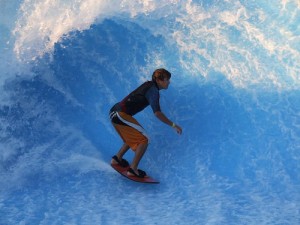 Here’s another one for all my Bujinkan Budo Taijutsu friends out there.
Here’s another one for all my Bujinkan Budo Taijutsu friends out there.
The following set of exercises is specifically designed to increase flow (nagare) in your taijutsu. However, before we get into the exercises themselves we should address the question, what is flow?
Flow is efficiency and continuity in movement. Flow is smoothness of movement that is unencumbered by mechanical, jerky actions. Moving at a faster pace and working harder, does not necessarily mean that the movement is flowing. In fact, if you are working harder, I can almost guarantee the movement is not flowing.
Get Out the Way – Move!
Flow is not something you do; it is something you get out of the way of!
What types of internal distractions, tensions, hitches in movement are preventing you from getting out of your own way?
The following flow exercises are culled from basic exercises of Bujinkan Budo Taijutsu, but can be utilized by anyone to expand your movement potential and increase flow.
When training these exercises, the idea is, of course, continuous movement. Begin with a slow and smooth protocol, working on keeping a good technique level and efficient transition between the movements. One discovers the key to developing flow by examining the in between stages of movement. Often, we see the kamae (structure) and then we see the roll, but what we miss is the essence of flow – the small, transitory movements between them.
Do not attempt to “accomplish” the exercise; that is not the point. Use it as a vehicle to unlock the flow in your movement. Try to keep moving. Don’t pause to think in the middle. Increase the speed as you begin to feel comfortable, but if the technique begins to get sloppy or the movements begin to look mechanical, drop down the intensity level until you are once again performing the flows with good technique. Remember, there is zero training value in simply trying to do the exercises for a “cardio” workout. Go buy a treadmill!
Chi No Kata
1. Step back from a natural posture into left leg forward Ichimonji No Kamae. Do Chi No Kata. From the end point of the kata, continue lowering your center of gravity and extend the right arm to effectively blend the transition from Chi No Kata into a front roll. Allow the momentum of the front roll to carry you to your feet, lifting up from the crown of your head and using your spine, into right Ichimonji No Kamae and, without stopping in the kamae, leap forward landing again in right Ichimonji No Kamae. Continue the movement by reaching forward with the left hand with a feeling of the body being pulled by the hand into left Ichimonji No Kamae. Repeat on the other side.
Sui No Kata
2. Step back from a natural posture into left Ichimonji No Kamae. Do Sui No Kata. From the omote shutou strike at the end of the kata, continue lowering the body with the weight on the front leg, simultaneously stepping through with the back leg to transition from the strike into a back roll. Allow the momentum of the back roll to carry you to your feet, lifting up from the crown of your head and using your spine, into right Ichimonji No Kamae and, without stopping in the kamae, leap backward landing again in right Ichimonji No Kamae. Repeat on the other side.
Ka No Kata
3. Step back from a natural posture into left Ichimonji No Kamae. Do Ka No Kata. From the ura shutou strike at the end of the kata, bring your left foot forward next to the right foot a little more than shoulder width apart to transition into Hira No Kamae. Without stopping in the kamae, lower your center of gravity and flow into a side roll to the right. Roll right back into Hira No Kamae and leap sideways to the right, landing again in Hira No Kamae. Repeat on the other side.
Fu No Kata
4. Step back from a natural posture into left Ichimonji No Kamae. Do Fu No Kata. Immediately transition to Hoko No Kamae and flow into a cartwheel. Land back in Hoko No Kamae and leap down into a kneeling Ichimonji No Kamae. Repeat on the other side.
Ku No Kata
5. Step back from a natural posture into left Ichimonji No Kamae. Do Ku No Kata. Immediately transition to a forward break-fall followed by a forward roll into Jumonji No Kamae. Leap directly upwards. Repeat on the other side.
Enjoy!
Flow drills from the book, Warrior Fitness: Conditioning for Martial Arts






2 Comments
David C. Furukawa
August 16, 2010Hi Jon,
Great training drills.When is the “Warrior Fitness” DVD coming out?Take care!
Dave
Jon
August 16, 2010Thanks Dave. The Warrior Fitness DVD will be out as soon as I unbury myself from the hundred other projects I’ve got going on! :o)
Leave A Response